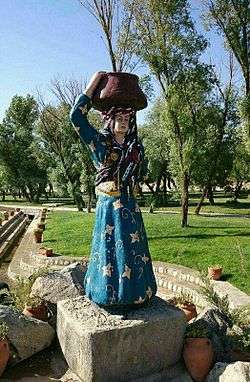Feyli Lurs
|
Feylis and their dialect | |
| Regions with significant populations | |
|---|---|
| The provinces of Lorestan, Ilam, Kermanshah in Iran. The provinces of Maysan, Diyala, Wasit in Iraq. | |
| Languages | |
| Luri, Southern Kurdish, Persian and Arabic | |
| Religion | |
| Shi'a Islam, Yarsanism | |
| Related ethnic groups | |
| Lurs, Kurds and other Iranian peoples |
Feyli Lurs, also Feyli Kurds and Feylis,[1][2][3][4] (Feyli: لوره یل فه یلی) are a group of Lur tribes[5] mainly live in Lorestan, Kermanshah and Ilam.[6] The Safavid era historian, Mirza Muhammad Husein Mostowfi (1749 A.D), classified Feyli alongside Laki, Bakhtiari and Mamasani as four subgroup of Lurs.[7] Austen Henry Layard (1887) described Feylis as the largest and the most powerful of Lur tribes inhabiting the mountains to the north of Dezful.[8]
Ethnogenesis
Feyli Lurs are a community living in Baghdad and the Diyala Province of Iraq around Mandali, and across the Iranian border, mainly in the provinces of Luristan and south of Ilam. The Feyli are an important community within the wider Lur people. Faylee (Faylee, Faili, or Feli) Iraqi Lurs are part of the Lurs in Iraq, though others believe they are much more related to Persians. Faylee have themselves shown, over the years, and still show this fact and reality by words and deeds. They speak Feyli, a dialect that belongs to the Luri language. Feyli is spoken particularly on both sides of the border areas between Iraq and Iran.[9] In addition to their Feyli Luri dialect, a special Luri clothing distinguishes Feyli Lurs from other Luri subgroups.[10]

Since ancient times, the Feylis have lived in the border area between Iraq and Iran, which consists of both sides of the Zagros Mountains, which they call it Kabir Kuh, "the great mountain". The areas on the Iraqi side from north to south are the following: some parts of Shahraban (now called Miqdadiyah), Khaneqin, Mandali, Badrah, Zurbatiyah, Gassan, Al–Kut and Al-Azizyah. They also reside in a number of cities in the area of Shaikh Sa’ad, Ali Al Sharqi, Ali Al-Garbi and Al–Kufa, which is 170 kilometres (110 mi) south of Baghdad. However, as early as the first decade of the 20th century, many Feylis moved to Baghdad and lived in its center. Consequently, there are some areas which are named after them, such as the Kurdish quarter, the Kurdish alley, and the Kurdish Street.On the Iranian side, the Feylis live in the following areas, from north to south: Kermanshah, Qasr-e Shirin, Eslamabad-e Gharb, Gilan Gharb, Eyvan, Sirvan, Chardavol, Ilam, Chavar, Badreh, Dehloran, Abdanan, Darreh Shahr, Meymeh, Pahleh.
Etymology
According to Michael Mehrdad R.S.C. Izady, the territory inhabited by the Pahli/Feyli people was known as "Pahla" (meaning "Parthia") since the 3rd century AD, outside proper Parthia (or Khorasan Province) in Iran.[11]
Contemporary history of Feylis
In the mid 1970s, Iraq expelled around 40,000 Feyli's who had lived for generations near Baghdad and Khanaqin, alleging that they were Iranian nationals.[12] In 2010, the Iraqi Ministry of Displacement and Migration reported that since 2003 about 100,000 Feylis have had their citizenship reinstated.[13]
See also
References
- ↑ Contributions to the anthropology of Iran, Henry Field
- ↑ "George N curazon's ethnological description of the feyli tribes [Archive] - Anthrogenica".
- ↑ "The Faili Kurds of Iraq: Thirty Years Without Nationality". ReliefWeb. 2 April 2010. Retrieved 22 February 2017.
- ↑ Nomadism in Iran From Antiquity to the Modern Era D. T. Potts
- ↑ Oberling, Pierre. "FEYLĪ – Encyclopaedia Iranica". www.iranicaonline.org. Encyclopedia Iranica. Retrieved 22 January 2017.
- ↑ C. A. de Bode, Travels in Luristan and Arabistan II, London, 1845, p. 290
- ↑ فرهنگ ایران زمین، جلد 20، ص 406-409
- ↑ Layard, Austen Henry (1887 (reprint; 2011)). Early Adventures in Persia, Susiana, and Babylonia: Including a Residence Among the Bakhtiyari and Other Wild Tribes Before the Discovery of Nineveh (2nd ed.). Camberidge University Press. p. 307. ISBN 9781108043434. Check date values in:
|date=(help) - ↑ H. Field, Contributions to the Anthropology of Iran, Chicago, 1939.
- ↑ Qaed Rahmat (2014), Clothes of Feyli Lurs in Luristan and Ilam (illustrated, revised reprint ed.), Qom: Motie Press
- ↑ Izady, M. R. (1992). The Kurds: A Concise Handbook. London. ISBN 9780737767582.
- ↑ P. Oberling, The Turkic Peoples of Southern Iran, New York, 1960.
- ↑ "The Faili Kurds of Iraq: Thirty Years Without Nationality". ReliefWeb. 2 April 2010. Retrieved 23 May 2017.

